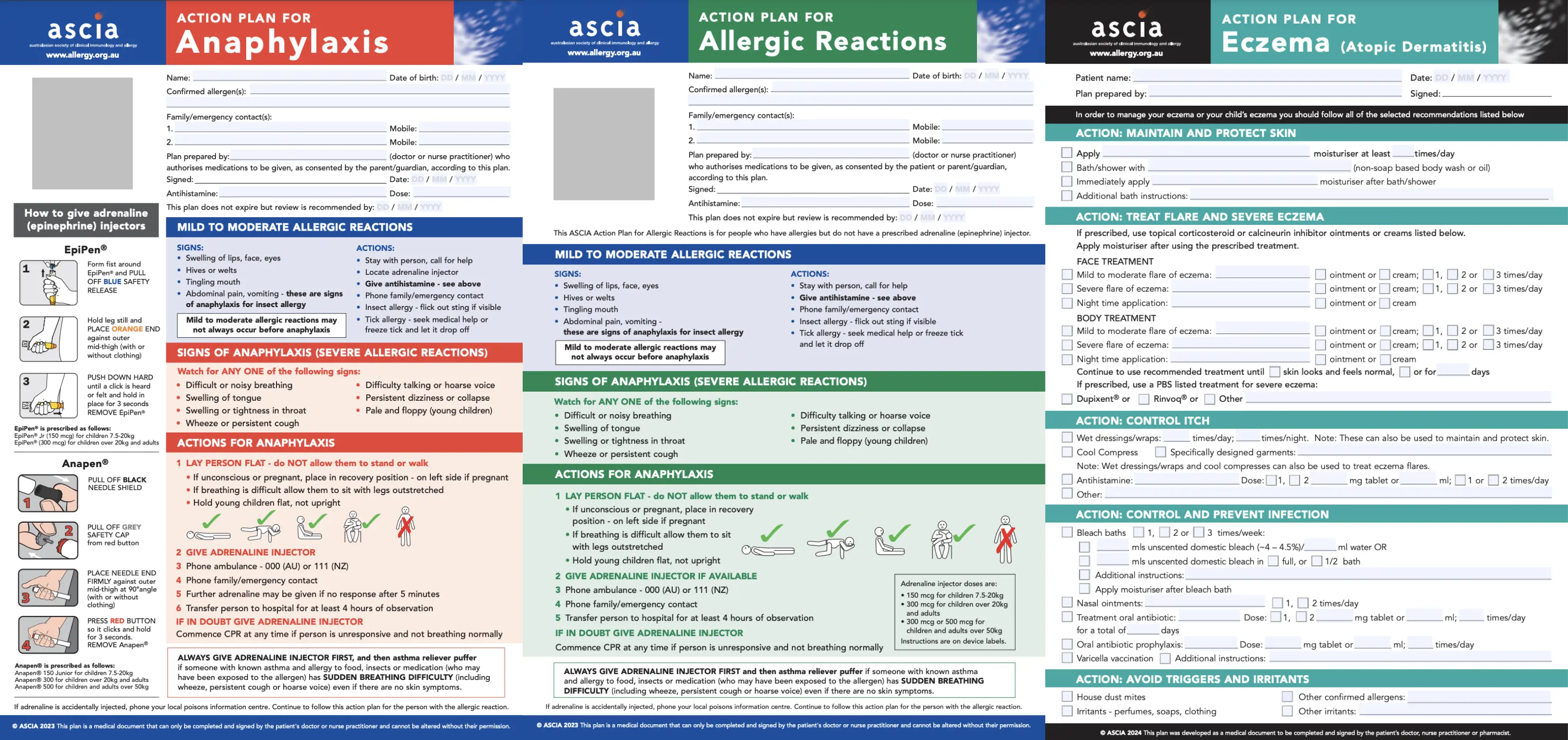An Asthma Action Plan is an essential tool for managing asthma effectively. Developed in collaboration with healthcare professionals, it is a personalised, written guide that helps individuals control their asthma symptoms daily and in emergencies.
Research consistently shows that people with an Asthma Action Plan experience fewer exacerbations and hospitalisations. A structured approach like this significantly reduces the likelihood of severe asthma attacks, improving overall quality of life, ensuring better health outcomes, and empowering you to manage your condition with confidence.
What is an Asthma Action Plan?
An Asthma Action Plan is a personalised document designed by your doctor to help you manage your asthma effectively. The plan provides clear, step-by-step instructions for handling day-to-day symptoms, managing flare-ups, and responding to emergencies. The plan should always be easily accessible to ensure it can be followed immediately when symptoms worsen.
According to the National Asthma Council Australia, individuals who follow a written Asthma Action Plan experience up to a 40% reduction in severe flare-ups and a significant decrease in hospital visits. The plan outlines how to monitor symptoms, adjust medications, and avoid triggers, all of which contribute to long-term control over the condition.
Key Components of an Asthma Action Plan
A comprehensive Asthma Action Plan includes:
-
Medications: A detailed guide on daily controller medications (such as inhaled corticosteroids) and emergency medications (e.g., bronchodilators).
-
Triggers: Identification of personal asthma triggers, such as pollen, dust, smoke, and pet dander, with strategies to avoid them.
-
Action Steps: Clear instructions for managing asthma in four distinct zones — green (well-controlled), yellow (when not well), orange (worsening), and red (emergency) — which reflect different levels of asthma control.
Research from Asthma Australia shows that individuals who adhere to their Asthma Action Plans experience fewer emergency situations and improved daily management. Each section provides a structured approach for preventing symptoms from worsening and ensuring timely responses.
Why You Need an Asthma Action Plan
Benefits of Having a Plan
Numerous studies highlight the benefits of having a written Asthma Action Plan. Research published in The Lancet found that individuals with a written plan experienced a 35% reduction in the need for emergency care and a lower likelihood of hospitalisation. Other benefits include fewer missed school or work days due to asthma symptoms and a reduced reliance on reliever medications.
An action plan empowers patients to intervene early when symptoms worsen, preventing mild exacerbations from escalating into severe attacks. This structured approach enhances symptom management, providing individuals with greater confidence and peace of mind in managing their asthma effectively, ultimately leading to improved long-term health outcomes.
Real-Life Impact
The positive effects of Asthma Action Plans are well-documented. According to a study published in the Journal of Asthma, patients who follow a personalised asthma action plan experience a 45% reduction in asthma-related hospitalisations.
Real-life examples underscore the value of these plans. One case study highlighted how a patient with previously uncontrolled asthma saw a 50% reduction in symptoms after adhering to their Asthma Action Plan. The National Asthma Council also reports that individuals with an active plan have improved self-management capabilities and experience fewer emergency situations.
How to Get an Asthma Action Plan
Scheduling an Appointment with Your Doctor
To create an Asthma Action Plan, schedule an appointment with your GP or healthcare provider. It’s helpful to prepare a list of concerns, symptoms, and triggers to discuss during the visit.
MyHealth, which has over 100 locations across NSW, QLD, and VIC, offers consultations with GPs who specialise in developing personalised plans. Research shows that regular consultations with a GP, combined with the implementation of a written action plan, can lead to improved asthma control and a reduced need for emergency care. Book your appointment today to take the first step toward better asthma management.
What to Expect During the Appointment
During your appointment, your doctor will review your asthma history, current symptoms, and known triggers. You may also undergo tests such as spirometry to assess lung function. Based on this assessment, your doctor will work with you to develop a personalised Asthma Action Plan that outlines your medications, steps to avoid triggers, and instructions for managing worsening symptoms. This collaborative approach ensures that your plan is practical, easy to follow, and tailored to your specific needs.
Asthma Action Plan Templates
Several reliable Asthma Action Plan templates are available online. These templates serve as a useful foundation for developing a personalised plan. Below are some trusted resources:
These templates provide clear, structured guides for managing asthma.
Who Develops an Asthma Action Plan
Asthma Action Plans are developed collaboratively between you and your healthcare provider, such as your GP or an asthma nurse. This collaborative process ensures that the plan is not only medically accurate but also tailored to your lifestyle and specific needs. By taking part in this process, people are better equipped to manage their asthma independently, improving outcomes and reducing emergencies.
How to Use and Interpret an Asthma Action Plan
An Asthma Action Plan is typically divided into four key zones — green, yellow, orange and red — which correspond to different levels of asthma control and the actions you should take:
-
Green Zone: This is where your asthma is well-controlled. You’re breathing easily, have no symptoms, and can carry out everyday activities without any issues. You should continue using your prescribed maintenance medications. Your lung function is 80% or more of your personal best.
-
Yellow Zone: Early warning signs appear in this zone, such as mild symptoms that include coughing, wheezing, or mild shortness of breath. At this stage, you may need to increase your reliever medication and closely monitor your symptoms.
-
Orange Zone: This zone indicates worsening asthma symptoms, including more significant breathlessness, persistent coughing, or wheezing. Lung function may range between 50% and 80% across yellow and orange zones. Immediate action is required, such as taking higher doses of medication. If symptoms don’t improve, contact your healthcare provider for further instructions.
-
Red Zone: This is an emergency. You may have severe shortness of breath, difficulty speaking, or tightness in your chest. Lung function is less than 50% of your personal best. You should follow your plan’s emergency steps, including using your rescue inhaler, and seek urgent medical help right away.
Understanding these zones helps you manage your asthma more effectively, ensuring you take the right steps as your symptoms change. Keeping your plan easily accessible allows you to act quickly, stopping small issues from turning into serious emergencies.

Asthma Action Plan by National Asthma Council Australia
How Often Should Your Asthma Action Plan Get Updated
Regular reviews and updates are essential for maintaining an effective Asthma Action Plan. The Australian Asthma Handbook recommends updating your plan annually or whenever there is a change in symptoms, medication, or lifestyle.
A study in the European Respiratory Journal found that individuals who updated their plans at least once a year were 40% less likely to experience uncontrolled asthma episodes. Regular updates ensure that the action plan remains relevant, helping to prevent exacerbations and maintain good asthma control by adjusting treatment as necessary and reflecting changes in your health.
Action Plans for Anaphylaxis, Allergic Reactions, and Eczema
In addition to asthma action plans, action plans exist for conditions such as anaphylaxis, allergic reactions, and eczema. While the structure is similar, each plan is tailored to the specific triggers and treatments of the condition.
For instance, anaphylaxis action plans emphasise allergen avoidance and the immediate use of adrenaline, while eczema action plans focus on skincare and inflammation management.
A study by Allergy, Asthma & Clinical Immunology in 2020 reported that individuals with written action plans for allergic conditions were less likely to require emergency interventions. These personalised action plans offer structured guidance for managing symptoms and preventing severe episodes.

Action Plan for Anaphylaxis, Allergic Reactions, and Eczema by ASCIA
References:
- National Asthma Council Australia. Asthma Action Plan – Why You Need One. National Asthma Council Australia. Published 2023. Accessed October 7, 2024. https://www.nationalasthma.org.au/health-professionals/asthma-action-plans/asthma-action-plan-library
- Asthma Australia. Asthma Action Plan Template. Asthma Australia. Published 2022. Accessed October 7, 2024. https://asthma.org.au/wp-content/uploads/2022/12/AA2023_Asthma-Action-Plan-A4_v19_colour_editable.pdf
- Global Initiative for Asthma (GINA). Global Strategy for Asthma Management and Prevention. Global Initiative for Asthma (GINA). Published 2022. Accessed October 7, 2024. https://ginasthma.org
- British Medical Journal. Patient Involvement in Developing Asthma Action Plans and the Impact on Asthma Control. BMJ. Published 2020. Accessed October 7, 2024. https://www.bmj.com
- Journal of Asthma. The Effectiveness of Written Asthma Action Plans in Reducing Hospitalisations. J Asthma. 2021;58(3):245-256. doi:10.1080/02770903.2020.1811798
- The Lancet. Asthma Action Plans and Their Role in Reducing Emergency Medical Care. Lancet. 2019;394(10202):837-845. doi:10.1016/S0140-6736(19)30311-4
- European Respiratory Journal. The Importance of Regularly Updating Asthma Action Plans for Long-term Control. Eur Respir J. 2021;57(5):210-221. doi:10.1183/13993003.01214-2021
- Allergy, Asthma & Clinical Immunology. The Impact of Action Plans for Allergic Conditions on Reducing Emergency Interventions. Allergy Asthma Clin Immunol. 2020;16(23):1-10. doi:10.1186/s13223-020-00461-2
- Australian Asthma Handbook. Guidelines for the Management of Asthma in Australia. Australian Asthma Handbook. Published 2023. Accessed October 7, 2024. https://www.asthmahandbook.org.au
- KidsHealth. Asthma Action Plan for Children. KidsHealth. Published 2022. Accessed October 7, 2024. https://kidshealth.org/content/dam/kidshealth/en/printables/kidshealth-asthma-action-plan.pdf
- Asthma and Allergy Foundation of America. Peak Flow Meters. Asthma and Allergy Foundation of America. Published 2024. Accessed October 7, 2024. https://aafa.org/asthma/asthma-diagnosis/lung-function-tests-diagnose-asthma/peak-flow-meters/#:~:text=Your%20doctor%20may%20need%20to,quick%2Drelief%20medicine%20right%20away.
- Australasian Society of Clinical Immunology and Allergy. ASCIA. Accessed October 7, 2024. https://www.allergy.org.au/













